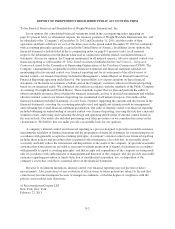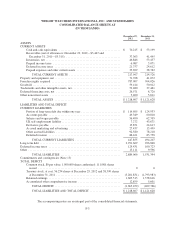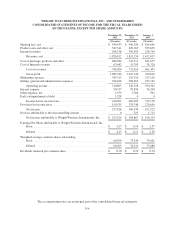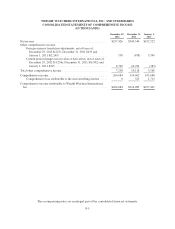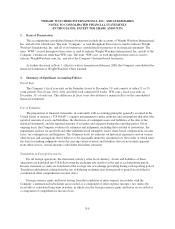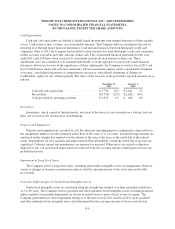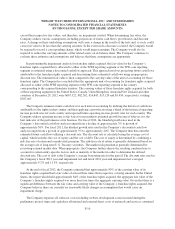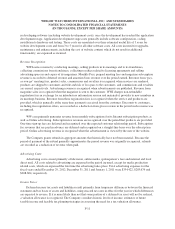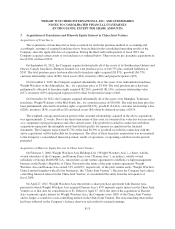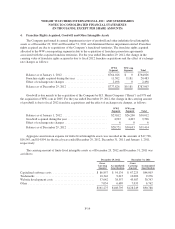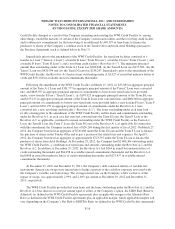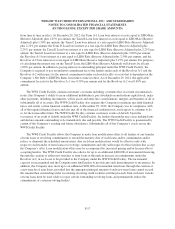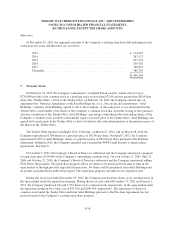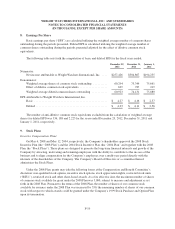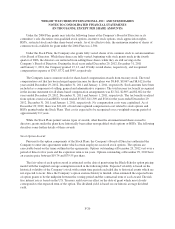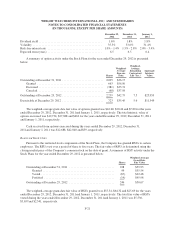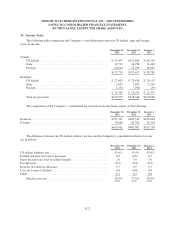WeightWatchers 2012 Annual Report Download - page 94
Download and view the complete annual report
Please find page 94 of the 2012 WeightWatchers annual report below. You can navigate through the pages in the report by either clicking on the pages listed below, or by using the keyword search tool below to find specific information within the annual report.WEIGHT WATCHERS INTERNATIONAL, INC. AND SUBSIDIARIES
NOTES TO CONSOLIDATED FINANCIAL STATEMENTS
(IN THOUSANDS, EXCEPT PER SHARE AMOUNTS)
In addition, assets and liabilities acquired in purchase business combinations are assigned their fair values
and deferred taxes are provided for lower or higher tax bases.
Derivative Instruments and Hedging:
The Company is exposed to certain risks related to its ongoing business operations, primarily interest rate
risk and foreign currency risk. The primary risk managed by using derivative instruments is interest rate risk.
Interest rate swaps are entered into to hedge a portion of the cash flow exposure associated with the Company’s
variable-rate borrowings. The Company does not use any derivative instruments for trading or speculative
purposes.
The Company recognizes the fair value of all derivative instruments as either assets or liabilities on the
balance sheet. The Company has designated and accounted for interest rate swaps as cash flow hedges of its
variable-rate borrowings. For derivative instruments that are designated and qualify as cash flow hedges, the
effective portion of the gain or loss on the derivative is reported as a component of accumulated other
comprehensive income (loss) and reclassified into earnings in the periods during which the hedged transactions
affect earnings. Gains and losses on the derivative representing either hedge ineffectiveness or hedge components
excluded from the assessment of effectiveness are recognized in current earnings.
The fair value of the Company’s interest rate swaps is reported in derivative payable and prepaid expenses
and other current assets on its balance sheet. See Note 15 for a further discussion regarding the fair value of the
Company’s interest rate swaps. The net effect of the interest payable and receivable under the Company’s
interest rate swaps is included in interest expense on the statement of income.
Investments:
The Company uses the cost method to account for investments in which it holds 20% or less of the
investee’s voting stock and over which it does not have significant influence.
Deferred Financing Costs:
Deferred financing costs consist of fees paid by the Company as part of the establishment, exchange and/or
modification of the Company’s long-term debt. During the fiscal year ended December 29, 2012, the Company
incurred deferred financing costs of $26,248 associated with the Tender Offer (as defined in Note 7). During the
fiscal year ended January 1, 2011, the Company incurred deferred financing costs of $11,483 associated with the
refinancing of the WWI Credit Facility (as defined in Note 6). Such costs are being amortized using the straight-
line method over the term of the related debt. Amortization expense for the fiscal years ended December 29,
2012, December 31, 2011 and January 1, 2011 was $7,070, $4,825 and $4,659, respectively.
Comprehensive Income:
Comprehensive income represents the change in shareholders’ deficit resulting from transactions other than
shareholder investments and distributions. The Company’s comprehensive income includes net income, changes
in the fair value of derivative instruments and the effects of foreign currency translations. At December 29, 2012
and December 31, 2011, the cumulative balance of changes in fair value of derivative instruments, net of taxes,
was $(6,602) and $(13,322), respectively. At December 29, 2012 and December 31, 2011, the cumulative balance
of the effects of foreign currency translations, net of taxes, was $19,461 and $18,923, respectively.
Reclassification:
Certain prior year amounts have been reclassified to conform to the current year presentation.
F-12


